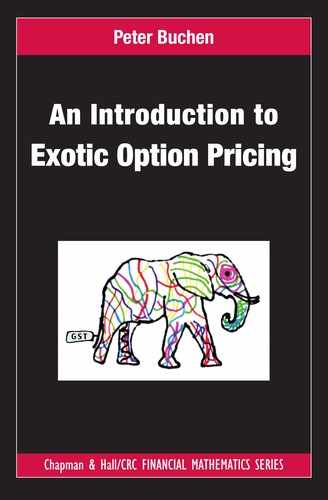Book Description
In an easy-to-understand, nontechnical yet mathematically elegant manner, An Introduction to Exotic Option Pricing shows how to price exotic options, including complex ones, without performing complicated integrations or formally solving partial differential equations (PDEs). The author incorporates much of his own unpublished work, including ideas and techniques new to the general quantitative finance community.
The first part of the text presents the necessary financial, mathematical, and statistical background, covering both standard and specialized topics. Using no-arbitrage concepts, the Black–Scholes model, and the fundamental theorem of asset pricing, the author develops such specialized methods as the principle of static replication, the Gaussian shift theorem, and the method of images. A key feature is the application of the Gaussian shift theorem and its multivariate extension to price exotic options without needing a single integration.
The second part focuses on applications to exotic option pricing, including dual-expiry, multi-asset rainbow, barrier, lookback, and Asian options. Pushing Black–Scholes option pricing to its limits, the author introduces a powerful formula for pricing a class of multi-asset, multiperiod derivatives. He gives full details of the calculations involved in pricing all of the exotic options.
Taking an applied mathematics approach, this book illustrates how to use straightforward techniques to price a wide range of exotic options within the Black–Scholes framework. These methods can even be used as control variates in a Monte Carlo simulation of a stochastic volatility model.
Table of Contents
- Preliminaries
- Symbols and Abbreviations
- Preface
- Part I Technical Background
- Chapter 1 Financial Prelinaries
- 1.1 European Derivative Securities
- 1.2 Exotic Options
- 1.3 Binary Options
- 1.4 No-Arbitrage
- 1.5 Pricing Methods
- 1.6 The Black-Scholes PDE Method
- 1.7 Derivation of Black-Scholes PDE
- 1.8 Meaning of the Black-Scholes PDE
- 1.9 The Fundamental Theorem of Asset Pricing
- 1.10 The EMM Pricing Method
- 1.11 Black-Scholes and the FTAP
- 1.12 Effect of Dividends
- 1.13 Summary
- Exercise Problems
- Chapter 2 Mathematical Preliminaries
- 2.1 Probability Spaces
- 2.2 Brownian Motion
- 2.3 Stochastic DE’s
- 2.4 Stochastic Integrals
- 2.5 Ito’s Lemma
- 2.6 Martingales
- 2.7 Feynman-Kac Formula
- 2.8 Girsanov’s Theorem
- 2.9 Time Varying Parameters
- 2.10 The Black-Scholes PDE
- 2.11 The BS Green’s Function
- 2.12 Log-Volutions
- 2.13 Summary
- Exercise Problems
- Chapter 3 Gaussian Random Variables
- 3.1 Univariate Gaussian Random Variables
- 3.2 Gaussian Shift Theorem
- 3.3 Rescaled Gaussians
- 3.4 Gaussian Moments
- 3.5 Central Limit Theorem
- 3.6 Log-Normal Distribution
- 3.7 Bivariate Normal
- 3.8 Multi-Variate Gaussian Statistics
- 3.9 Multi-Variate Gaussian Shift Theorem
- 3.10 Multi-Variate Ito’s Lemma and BS-PDE
- 3.11 Linear Transformations of Gaussian RVs
- 3.12 Summary
- Exercise Problems
- Figure 3.1
- Chapter 1 Financial Prelinaries
- Part II Applications to Exotic Option Pricing
- Chapter 4 Simple Exotic Options
- 4.1 First-Order Binaries
- 4.2 BS-Prices for First-Order Asset and Bond Binaries
- 4.3 Parity Relation
- 4.4 European Calls and Puts
- 4.5 Gap and Q-Options
- 4.6 Capped Calls and Puts
- 4.7 Range Forward Contracts
- 4.8 Turbo Binary
- 4.9 The Log-Contract
- 4.10 Pay-at-Expiry and Money-Back Options
- 4.11 Corporate Bonds
- 4.12 Binomial Trees
- 4.13 Options on a Traded Account
- 4.14 Summary
- Exercise Problems
- Figure 4.1
- Chapter 5 Dual Expiry Options
- Chapter 6 Two-Asset Rainbow Options
- Chapter 7 Barrier Options
- 7.1 Introduction
- 7.2 Method of Images
- 7.3 Barrier Parity Relations
- 7.4 Equivalent Payoffs for Barrier Options
- 7.5 Call and Put Barrier Options
- 7.6 Barrier Option Rebates
- 7.7 Barrier Option Extensions
- 7.8 Binomial Model for Barrier Options
- 7.9 Partial Time Barrier Options
- 7.10 Double Barriers
- 7.11 Sequential Barrier Options
- 7.12 Compound Barrier Options
- 7.13 Outside Barrier Options
- 7.14 Reflecting Barriers
- 7.15 Summary
- Exercise Problems
- Figure 7.1
- Chapter 8 Lookback Options
- 8.1 Introduction
- 8.2 Equivalent Payoffs for Lookback Options
- 8.3 The Generic Lookback Options m(x,y,t) and M(x,z,t)
- 8.4 The Standard Lookback Calls and Puts
- 8.5 Partial Price Lookback Options
- 8.6 Partial Time Lookback Options
- 8.7 Extreme Spread Options
- 8.8 Look-Barrier Options
- 8.9 Summary
- Exercise Problems
- Figure 8.1
- Chapter 9 Asian Options
- Chapter 10 Exotic Multi-Options
- 10.1 Introduction
- 10.2 Matrix and Vector Notation
- 10.3 The M-Binary Payoff
- 10.4 Valuation of the M-Binary
- 10.5 Previous Results Revisited
- 10.6 Multi-Asset, 1-Period Asset and Bond Binaries
- 10.7 Quality Options
- 10.8 Compound Exchange Option
- 10.9 Multi-Asset Barrier Options
- 10.10 Summary
- Exercise Problems
- References
- Chapter 4 Simple Exotic Options
